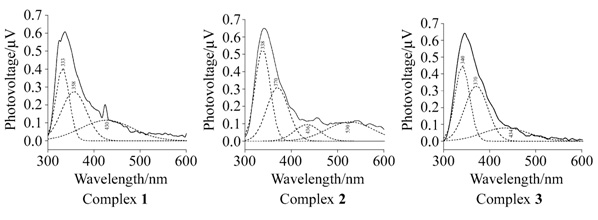化学学报 ›› 2009, Vol. 67 ›› Issue (18): 2087-2094. 上一篇 下一篇
研究论文
史忠丰 金 晶 牛淑云* 张 丽 李 雷 迟玉贤
Shi, Zhongfeng Jin, Jing Niu, Shuyun* Zhang, Li Li, Lei Chi, Yuxian

采用水热合成方法得到了3种Co(II)配合物: [Co(μ4-btec)0.5(phen)(H2O)]n (1), [Co2(μ4-btec)(bipy)2(H2O)2]n (2), [Co2(μ2-btec)(phen)2(H2O)4] (3) (phen=1,10-phenanthroline, bipy=2,2’-bipyridine, H4btec=1,2,4,5-benzenetetracarboxylic acid). X射线单晶衍射结果表明: 3个配合物都是以均苯四甲酸根做为桥, 分别形成了2D, 1D和双核结构. 但在3种配合物中, 均苯四甲酸根的配位模式各不相同, 分别采用了μ4-η1η2η1η2, μ4-η1η1η1η1, μ2-η1η1η1η1配位模式. 此外, 分子间大量氢键的存在和π-π堆积作用又将3个配合物网成了3D无限结构. 通过红外光谱(IR)、电子吸收光谱(UV-Vis-NIR)及表面光电压光谱(SPS)等方法对配合物进行了表征. 3种配合物的表面光电压谱研究表明: 它们在300~600 nm范围内均有正的光伏响应. 将SPS与其电子吸收光谱进行关联, 发现它们基本上是一致的.